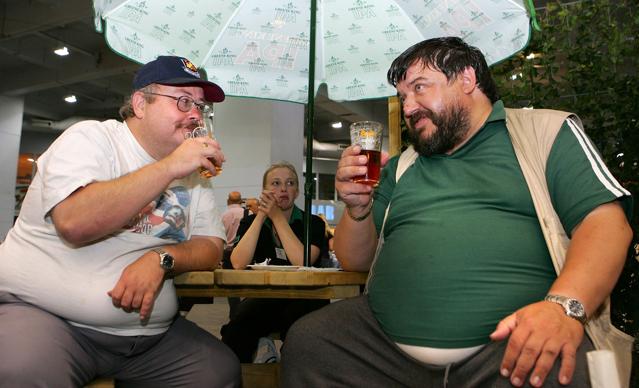
“We need a dad,” an acquaintance recently remarked about an executive search happening at his company. He went on to explain what he was hoping for was that they’d choose someone for a C-suite role who, when the metaphorical you-know-what hits the fan, has seen enough actual you-know-what to be able to deal with it competently. Of course, he wasn’t directly involved in the hiring process and his company knows better than to flout employment laws with questions on family status, but his valorization of the dad archetype comes at a particularly apt time.
After all, dads and their bodies, the appropriately dubbed “dad bod” or “dadbod” are enjoying a pop cultural moment. If you aren’t familiar with the dad bod phenomenon, all you need to know is that the internet has recently discovered that middle-aged men are corporeal beings and their corpuses might be less toned, fit and manscaped than those of gym-going counterparts in their 20s. The internet cannot make up its mind if we should be celebrating these physical specimens by waxing poetic about their hitherto unacknowledged attractiveness or whether we should be blanching in disapproval at slideshows of the likes of Guy Fieri and Adam Sandler cavorting shirtless on the beach. At present, the former camp is winning.
Dad bod isn’t anything new. Before we idolized the abs of Adam Levine and Channing Tatum, fatherly figures were the norm. Watch clips of wrestlers from the pre-PED 70s and 80s and you’ll see more barrel-chested dad bods than chiseled forms. In a 2010 profile on the late Dino Bravo for DeadSpin, David Shoemaker refers to the squat wrestler’s “my-buddy’s-strong-dad physique,” for example. And in a 200o piece for Salon, Kim Morgan bemoaned the fact that movies no longer feature husky leading men, equating a solid, imposing physical presence with a fading strain of traditional masculinity.
What’s interesting about dad bod isn’t necessarily the obvious discussion it has spawned about sexism and male privilege — of course there’s a double standard in celebrating flabby middle-aged men while shaming women for the same “figure flaws” or rewarding them with MILF status for avoiding this fate. No, what’s interesting is that we’re ogling imperfect, aging bodies in an era when we’re also hyper-focused on beating the clock on that same aging and fighting mortality at every turn.
We see this preoccupation in the tech sector, with companies like Google-backed Calico, which is planning a $500 million research facility to study aging and age-related diseases and has research partnerships with institutions like Harvard and MIT lined up. Speaking of Google and Harvard, Google X, which is the company’s somewhat shadowy research facility focused on large-scale tech innovation, just wooed a rising star cardiologist from Harvard Medical School to head up a major new study on understanding health outcomes at a molecular and cellular level. In March, health startup Alkahest landed a $50 million investment from pharmaceutical multinational Grifolis to fund work in fighting neurodegeneration. That same month, Apple unveiled ResearchKit, essentially enabling crowdsourced medical research, as part of its Apple Watch event. If we’re able to achieve singularity by 2030, surely a cure for the common death can’t be far behind?
We also see anxiety over physical degeneration and the attempts to combat it at the level of the individual. In the booming wearables industry, we’ve graduated from the humble pedometer to sophisticated devices that tell us how much we’re exercising, how well we’re sleeping, how many calories we’re burning, when we’re due to ovulate and how good our posture is, to name but a few metrics. We can now map our personal genome. We spent a whopping $12 billion on plastic surgery in 2014. And when the knife isn’t enough, we can use hormones to stave off the effects of aging and maintain virility. We’ve moved from the relatively passive data collection focus of the quantified self to the aggressively interventionist paradigm of biohacking championed by the likes of Tim Ferriss and his Four-Hour Body guide. It is no longer enough to understand ourselves body and soul, we must transform ourselves via righteous self-improvement — in the interests of increasing quality of life, physical stamina, longevity and youthful appearance — as well.
Unlike a pretty young woman who cheekily experiments with dying her hair gray, dad bod offers a more serious pushback against this new way to be embodied. A man with dad bod is not a man who hacks his sleep habits. He isn’t eating Paleo or doing CrossFit. Clearly. He’s likely not uploading his picture to Microsoft’s age-guessing website and fretfully comparing the results to his chronological age. His body is a testament to his disengagement from or rejection of the fight against physical decline and death, or if he is engaged in the fight, it’s proof that he’s not winning it. It makes sense that we are both fascinated by the dad bod and fearful of its connotations (Is that me now or in the future? we wonder). We are also envious of it, especially when modeled by celebrities, as it hints at a person who has transcended the appearance pressures the rest of us feel weighed down by. Dad bod breaks the rules and if we are unable to police it into conformity, then it seems like the logical choice is to fetishize it as a way of robbing it of its power — as we’ve done to women’s bodies for centuries. Deep down, what we know but don’t want to face is that the dad bod’s spare tire is a sign of our mortality and a confirmation that all the clean living in the world won’t help us outrun the ultimate dad himself — Father Time.
[“source-forbes.com”]







